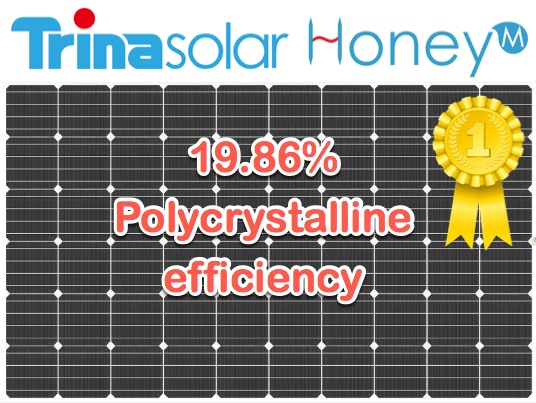
Trina have set a record 19.86% aperture efficiency for polycrystalline.
Trina Solar announced a new world record for solar panel efficiency on Tuesday. The announcement was made via a press release that was mostly comprised of words.
But that wasn’t all it contained. Oh no, this press release was far too important to get by just using them. It also contained numbers, punctuation, and percentage signs.
Exactly what the particular arrangement of all these ingredients they poured into their press release actually means is a little tricky to work out. But, for your elucidation, I shall now attempt reading comprehension and I am not even going to use a net.
19.86% Efficiency – A New World Record For Polysilicon
Trina Solar has achieved a new world record for efficiency of a polycrystalline solar panel of 19.86%. This is a definite improvement on the previous record of 19.5% set by Hanwha Q Cells in June.
This may not seem terribly impressive compared to the record for monosilicon of 24.1%, but I’m impressed because polysilicon is cheaper and so doesn’t need to have as high an efficiency to be competitive on price per watt.
Some efficiency snobs are not impressed with polysilicon’s lower efficiency and consider it to be monosilicon’s blue haired stepchild (which in Australian parlance would make it a red haired stepchild) and consider it beneath them. But they’d probably find it works a lot better if they put it above them, like on their roof.
Bad News – It Is Aperture Efficiency
Unfortunately, the 19.86% record is for aperture efficiency. If you look up the dictionary definition of aperture then this does not seem to make a lot of sense, as an aperture is simply a hole. How can a hole be more or less efficient at being a hole? Sure, some people might say that Toowoomba is a very efficient aperture, but they are just being mean.
But in this context aperture simply means the area of the panel that is covered in solar cells and does not include the frame. This means the actual efficiency of the solar panel will be about 6% less which would make it roughly 18.7%.
It’s A Honey Plus Panel
The efficiency record was achieved using a Trina Solar Honey Plus panel. Trina Solar first introduced them back in 2012. They were a leader in efficiency then and it looks like they are working hard to keep leading.
A standard Honey panel has 60 solar cells in it while the press release says the record breaking panel had 120. They achieved this doubling by cutting their standard sized solar cells in half. This wasn’t done to win a prize for having the most cells in a panel. (That’s already been taken.) It is instead a technique for eking out a little more performance.
Also included in the bag of tricks to boost efficiency was a thing called Passivated Emitter and Rear Cell or PERC. What kind of a thing is that? Why, it is a thing that perks up the performance of your solar panel of course! I would look it up on the internet for you, but in the introduction I said I would not use a net, so I cannot.
Trina Solar also said they used highly efficient light trapping, which is very interesting because it made me wonder how many solar panel manufacturers out there are still using highly inefficient light trapping?
Will It Be On The Market Soon?
I assume Trina will be in a hurry to get the technology used in their record breaking panel into production. There are no prizes for failing to beat the competition in business, unless you count a sudden unplanned and unpaid increase in leisure time as a prize. But there is always going to be a lag. Making changes to a solar panel fabrication line is not easy.
Currently the best polysilicon Honey panel available is around 17.1% efficient. That would give it an aperture efficiency of around 18.8%. So at the moment there is about a one percentage point lag between a panel you can buy and what they have tested in the lab. This gap may get smaller in time, but I doubt it will get much larger.
Find out which solar panels are the most efficient in Australia.

 RSS - Posts
RSS - Posts



Hi,
I’m in the final decision of deciding what system to get. I am located in Western Suburbs of Sydney. I have narrowed it down to these 2 options and having a lot of trouble deciding:
Installer 1 – 21 x 290w Jinko mono eagle PERC & SMA 3 phase inverter including metering = $6290. This installer uses grace solar racking and ZJ Beny DC isolators.
Installer 2 – 21 x 290w Trina mono panels & SMA 3 phase inverter including metering = $6750. This installer uses clenergy solar racking and IMO DC isolators.
Can you please make a recommendation.
Hello Anthony. I’d say two systems are more or less comparable in quality. As far as Jinko and Trina panels are concerned, I don’t have enough information to say one is better than the other. I currently lean towards Jinko, but the evidence making me lean that way isn’t substantial.
Thank you,
What do you think between ZJ Beny and IMO DC isolators?
I’m not aware of any safety difference between them. They both have 5 year warranties and are similar in price.